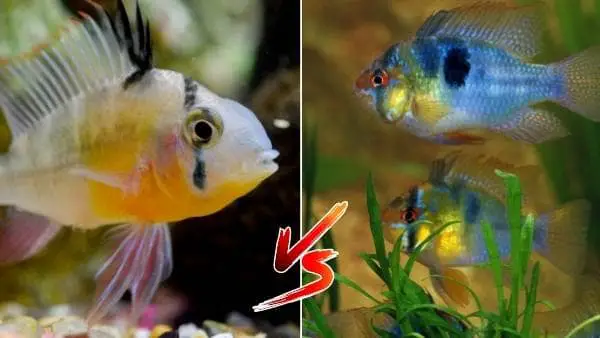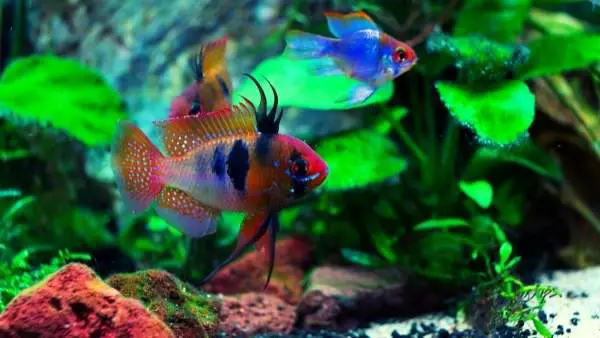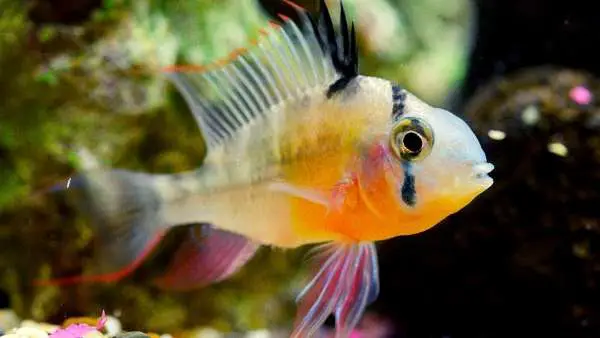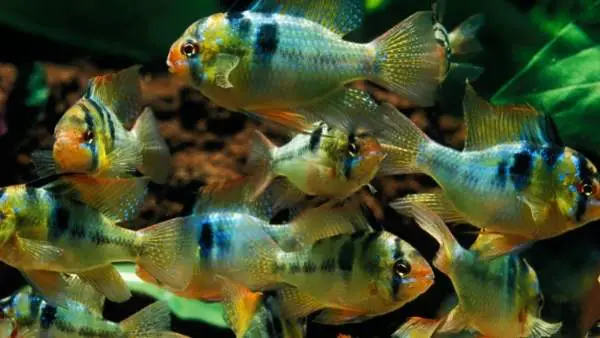The cichlid fish family is an extensive one, to say the least, with more than 1,300 different species of Cichlidae (order Perciformes). Both the bolivian ram and german blue ram are considered to be some of the more peaceful fish from this family.

Whilst they are both very similar in appearance and personality, there are some considerable differences between the two. Bolivian rams are lower maintenance and can handle cold water much better, they are also bigger than the German blues, and are much easier to breed.
Similarities and Differences
Despite having a few differences, there are some pretty glaring similarities when it comes to both of these fish. The visual similarity is the sheer beauty of both of these fish with German blue rams being extremely colorful and showcasing a plethora of colors. They have bright yellow bodies and a green head, with light blue/white coloration being displayed throughout the rest of their bodies.
Bolivian rams are less colorful, but still show off many bright colors and unique patterns, the main color displayed is a yellow/grey coloration that dilutes into different shades across their bodies.
Same Diet
Both of these fish are omnivores so they need to maintain a balanced diet by eating meat, plants, and algae. By feeding both fish sinking pellets, freeze-dried bloodworms, and freeze-dried tubifex worms you will certainly find yourself in their good books.
Whilst german rams are much pickier eaters than bolivian rams, they both require a very similar diet, so, feeding them some of these suggestions is a good idea. Both Bolivian and German blue rams eat shrimp live or frozen, which is another good addition to their diet.
Similar Personalities
Both fish are incredibly well-tempered and will not cause any problems to your aquarium community by being over-aggressive. On occasion, bolivian rams can become a little hostile towards each other over territory and breeding rights. If you notice your bolivian rams fighting, keep a close eye on them to make sure there is no damage being done.
They Brighten Up Any Aquarium
German blue rams showcase an incredible array of colors and patterns, and will certainly draw the attention of anyone looking at your tank. Their playful nature makes them so fun to observe too, adding serious value to any community they find themselves in.
Bolivian rams are very much the same, if not a little more timid and shy than their German counterparts. The males will not fight to the death and in general, bolivian rams get along with most other fish.

Similar Pricing and Availability
Due to their popularity, both of these rams are widely available, in fact, they are the most popular two cichlids! Their price point is almost identical too, although bolivian rams can be more expensive due to the sheer demand for them. Bolivian rams are around $10 USD, and a good german blue ram will cost roughly $8 USD.
Bolivian Ram vs German Blue Ram Differences
Despite there being a fair few similarities between these two types of ram cichlids, there are many differences. Let's dive in!
Size and Appearance
Both fish are incredibly colorful, however, there are some big differences in both fish's appearances. German blue rams are typically smaller, growing to around 2 inches (5.1 cm) in length, whereas the bolivian ram can grow to around 3.5 inches (8.9 cm) in length.
German rams are known as rainbow rams for good reason, and whilst bolivian rams are incredibly colorful, they are nowhere near as colorful as the german blues.

Behavior
Both of these fish have very peaceful personalities, however, bolivian rams are certainly more shy than german blue rams are. You will have to provide your bolivians with plenty of hiding spaces to keep them settled.
German blue rams, however, are much more courageous and will spend most of their time swimming frantically around, dancing around, and providing much entertainment for you and their tank mates.
Bolivian rams tend to swim differently too, adopting an unusual swimming technique of three fin strokes and then a pause, before doing it again and again. German blue rams swim around as most fish do.
Additionally, bolivian rams are considered to be the more intelligent of the two, and you can observe this for yourself when you see their interactions with objects in the tank. Bolivians also follow hobbyist fingers, which is considered to be something only intelligent fish can do.
Tank Requirements
The main difference between both cichlid species is their tank requirements, hardiness, and adaptability. German blue rams need warm water, and their temperature should be between 78-85°F (25.6 to 29.4℃) in order for them to survive. Additionally, they will need a slow-moving current and subdued lighting, their pH level should be in the 6 to 7.5 range. German rams are certainly more fragile than bolivian rams.

Due to their hardiness, bolivian rams can adapt to many different water environments. They do not need a specific water temperature, and they will survive in water with low or high pH levels. To ensure a healthy and happy life for your bolivian rams, it is advised to replicate their natural environment. For the bolivian ram, you will need a 30 gallon (113 liters) tank or larger and for the german blue ram, you will need to acquire a 10 gallon (38 liters) fish tank or larger.
Final Thoughts - Which Should You Choose?
So, as you can see there are many differences and similarities between both of these cichlid species. As a hobbyist deciding which of these rams to purchase you should consider all the differences and find out which one will suit you, your tank, and your fish community the best.
If you are a hobbyist with minimal experience then you may choose the bolivian ram as it is easier to care for, but equally, if you are experienced or have moderate fishkeeping skills and want to add more unique colors to your aquarium, the german blue ram is perfect for you!
Both fish are incredibly colorful and also peaceful and will make a brilliant addition to any aquarium they are introduced to.
